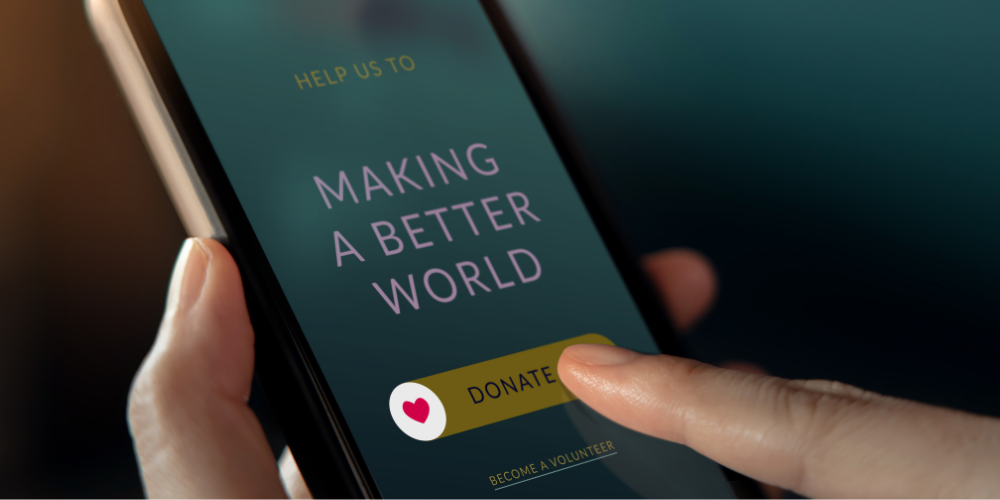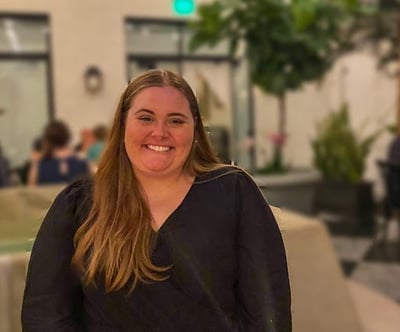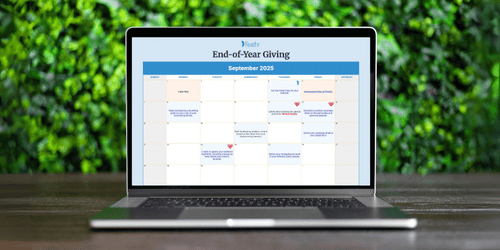
8 Best Practices for End-of-Year Marketing Campaigns
It’s finally here! The moment we’ve all been waiting for …
Ok, ok, we understand that the end-of-year season brings a few stressors too.
But with a little hard work and creativity, year-end marketing is a unique opportunity to push your organization forward. And with a little hard work and a lot of fun, we're convinced that this year-end will be one to remember.
We’re going to jump into 8 best practices to ensure this end of year rocks, but before that, I want to introduce you to Feathr's year-end campaign experts: Erin Ford and Chandler McFarland. Erin and Chandler have run hundreds of end-of-year marketing campaigns for nonprofits — from pet shelters to rescue missions to local theaters — so they know how to cut through the noise during this incredibly busy season.
And with their combined experience, they have 8 ideas that can help you bring this year to a smooth landing:
- Stick to your bread and butter: Email.
- Market to the right people.
- Try things!
- Now try them together!
- People follow people.
- You're not the protagonist.
- Stop looking for a magic spell.
- Keep following up in the new year.
So now let's dive a little deeper into each one so you can see how it applies to the work you're doing!
1. Stick to your bread and butter: Email
Erin is pretty open about her love of email. She said, “I'm a big fan of email. I've seen the most success throughout the year with email.”
Just because email isn’t new doesn’t mean it has to be stale. My guess is that you’ve been in your inbox already today, and you’ve likely read some great emails and some other ok ones. So how do you stand out in the inbox?
One of Erin’s favorite tricks is writing emails that speak to the moment.
“I think what's worked best for me is tying seasonality in,” Erin said. “I worked with an organization called Highway 80 who did a summer campaign. They serve the homeless and those in need. And the campaign performed really well because it was clear that these people needed to get out of the heat.”
Email, although we use it to speak to everybody, is ultimately a one-to-one channel. When someone opens their inbox, they’re reading an email directly to them. And this is part of why it’s so important to master the channel.
There are three other recommendations we have for taking your email just one more step:
- Segment your audience: Make sure that you’re sending your major donors different emails from your volunteers. It’s important when someone opens that email from your organization that they feel understood and valued.
- Show the subject line some love: The body content of the email is often the primary focus, but nobody reads that unless the subject line captures their attention. Make it too flashy and it feels like click bait, but make it “Newsletter #582” and it’s probably not flashy enough. Here are a few more tips for navigating subject lines.
- Leverage automated emails: Automation isn’t primarily about efficiency, although it will save your team a lot of time. It’s really all about connecting the right message with the right people at the right time. It’s never too late to thank someone, but a thank you email definitely has a larger impact when it’s closer to the donation.
2. Market to the right people
It’s often said that marketing is about getting the right message at the right time to the right people. But the messaging and the timing are really so dependent on that third piece: the people. So step one is always understanding your people – that way you can develop the messaging and deliver it to them where they are and when they’re there.
So much of marketing to the right people is about segmentation, or breaking your audience into smaller groups so that your messaging is highly relevant to them. Your volunteers think about your organization differently than your recurring donors. And your staff or board should see a different email — yes, internal communications are a form of marketing — than major donors.
Show someone that you care about them by getting to understand the context and intent of their relationship with you. What do we mean by context and intent? Here are our working definitions:
- Context: This is what’s known about the audience and what the audience knows about you. Are they long-time supporters? Have they attended a recent event? Or did they stumble onto the website for the first time last week? Context ultimately boils down to how a community member defines their relationship with your organization.
- Intent: This is all about anticipating what your audience wants to do. If a past donor navigated to a donation page, but failed to make a donation, it can be assumed that it was their intent to give. The same is true if they visited a registration page for an upcoming event or if someone began to fill out a volunteer sign-up form. Intention is ultimately about looking for signals of future action.
3. Try things!
The best marketers are both artists and scientists. I’m in the process of writing an article about 8 best practices, but I’ve got a secret for you: this isn't science. What works for our audience may not work for your audience, and vice versa.
Instead of looking toward someone like me or Chandler or Erin (although Chandler and Erin would be at least a better start than me!), look to your own conversations with your community. Look at your own numbers and think of ways to push the needle on the things that are already working.
But then there will come a time where you need to try some new things! This is exciting!
The best marketers aren’t just throwing ideas at a wall or hoping they’ll win the lottery with some team member’s contribution. They focus on the things that work while developing a hypothesis or two about places where more energy could pay off.
During our very first Good Marketing Unplugged podcast session, we were joined by Brady Josephson from charity: water, and his ideas about testing have very much influenced our own understanding on the subject.
He broke tests up into three categories: tries, pilots, and experiments:
- Try: This is just what it sounds like; you’re simply doing something new. Now there’s still a value in deciding where to try things and what to try, but it’s important to not place a ton of pressure on the performance of these tests in the short term. You don’t have the energy or time to make pilots or experiments of every single test you’re taking. So sometimes just try something, and then make sure you measure what happens.
- Pilot: This is a test with a little more prep work. But the added prep work allows you to invest more energy and time into the project. Placing parameters on how long the test will run and what you would consider a success or failure are key here. Because you’re putting more into this, you need to begin to expect more out of it. Make sure that you give things the time and energy they deserve, so that you don’t make conclusions before they’re actually available. But pilots protect you from trying something indefinitely and with an infinite budget — because my guess is that just like us, you aren’t working with an infinite budget.
- Experiments: This is actual science here. Although the caveat is that you’re measuring people’s reactions. And people tend to be a little unpredictable. It’s really all about the setup. When you hear experiment, think A/B tests. You should have a control group, a test group, and data integrity. Form a hypothesis to justify the experiment’s existence. If you don’t think the results will be actionable, build an experiment elsewhere where you think it will be insightful. Only after you run out of intuitions about what to experiment on (which will likely be never) can you move on to things that you don’t think will matter (this is sort of a joke — probably be better to spend your time on something else at that point).
Erin believes that much of her expertise is directly related to the volume of tests that she’s been able to run, especially during the end of year, which is so important for nonprofits.
She said, “End of year is a key moment to do testing. You’ve got to test everything and anything to see what sticks with your audience, especially for us because we have such a high volume of customers.”
Try to get a lot of your tests and pilots out of the way during the early part of the year. That way when it comes time for end-of-year marketing campaigns, you’re ready to really test those hypotheses. But be openminded even at the end of the year because if you listen closely, you can make next year’s campaigns even better.
4. Now, try things together!
We believe that stereo marketing is always better than mono. By that we mean that orchestrating multiple campaigns, playing the same tune, creates a bigger movement than simply relying on direct mail or email or display advertising alone.
Can each make an impact alone? Of course! But each is going to go further when they’re working in sync.
We know how hard it is to try new things, and now we’re saying to try them all together! I know, it sounds like a lot. But in Chandler’s words, “Pick the one thing you're not doing and do that, and you're gonna learn lessons along the way, either from mistakes or from how much it worked!”
Erin worked with an organization called Love Without Boundaries, and she saw such a lift simply by adding retargeting campaigns into the overall mix. She said, “Essentially for the end of year, we focused on retargeting ads. The two campaigns only spent about $200 and they got about $8,000 in ROI. I think it was simply just a piece of the puzzle in terms of adding reminders to their marketing funnel.”
5. People follow people
Floyd Jones from GiveButter defines brand as the sum total of every interaction a person has with your organization. That’s every phone call, every email, every ad. Everything.
And more and more, people aren’t wanting to know what your organization thinks because they know your organization thinks like the people inside it. So they just want to know what you think.
Every organization should have a different flavor because it’s made from mixing different people together. But whatever the flavor is, it should be human. People want to see behind the curtains and know the people who make your organization work.
People are more likely to interact with an ad with a smiling person than almost any other image. That’s because we experience empathy with other people. It’s so much harder to scroll past a video with a person’s face on it rather than a branded image.
So put your best foot forward — and by that I mean you! Be yourself, and the donors, supporters, and members will flock to you.
Erin said on the subject: “It’s hard for nonprofits to get out of the revenue mindset as they approach donors. But it’s essential for fundraisers and marketers to look at these people as relationships and partners. What can you offer the donor in value? What does your email strategy look like? Do you have a thank you series lined up?”
The name of the game is connecting with donors, members, and supporters on a deeper level than money.
6. You’re not the protagonist
Everyone in the nonprofit and association space is talking about storytelling. And that’s because it’s so essential when talking to people. This follows well from the last point because it’s all about human psychology. People get a rush when they hear a great story.
But a lot of that rush is because they put themselves in the story. And the more your stories invite people into the action, the more impact those stories will have.
Shout from the rooftops the work that you’re doing to change the world. But shout even louder when you share the impact that donors or members of your community make when partnered with your organization.
We’re just saying for us, the story is about you, but for your community, the story should be about them. They’re ultimately the real drivers for the sustained success and impact of your work.
There are a lot of artists out there who love their fan base. But Ariana Grande and Taylor Swift have really tapped into that power. And it’s made them unbelievably successful. If you hear either of them talking, it’s so clear that their people are their drivers.
If you make other people feel special, they’ll work with you for a very long time. And the world will be all the better for it.
7. Stop looking for a magic spell
So much of what we’ve been talking about in this article is the idea that there isn’t just one answer for end-of-year marketing campaigns. Good marketing isn’t magic, it’s measurable, strategic, and far sighted.
Chandler, when we first started talking about end-of-year campaigns, brought up an amazing example with Hope & A Future. But his main caveat was that the success was so much based on the hard prep work that made it all possible.
He said, “I feel like some nonprofits might look at this and think ‘if we can spend $6,700 for $66,450, we’re in!’ But no, there's a lot of preliminary work they've been doing and a lot of what we did together was just boosting that frequency. We're just a piece of that pie chart.”
8. Keep following up in the new year
Leveraging a tracking pixel on your website is key all year round, so you can serve personalized ads to your web visitors as they browse other sites. However, it's particularly powerful during seasons when your web traffic is likely to peak: Giving Tuesday and the last few weeks of the year.
The people who are researching your mission or clicking on your ads leading up to these big giving days might not immediately become donors – but they're clearly interested in the work you're doing. By leveraging website tracking data, you can continue engaging them with ads (and emails, if they've shared their contact info) to stay top of mind well beyond giving season. That little bit of nurturing can go a long way in winning over more donors in the new year.
Wrapping up
The nonprofits that are going to win at the end of the year are going to have started earlier than their peers in building deep relationships with their community. In fact, here's our year-end fundraising calendar template that has helped lots of nonprofits start strong with their EOY efforts.
Chandler identifies marketing almost as a type of lifestyle instead of an activity. He said, “I feel like marketing is a 24/7, 365 thing.” This shouldn’t be used as justification to work too many hours. But marketing should be a part of your DNA. It’s telling human-centered stories to the people you care about.
And it ends up making a huge impact for your organization — and so also the world!
About our end-of-year experts:

Erin Ford is the Team Manager for our Managed Services team. She's also a proud mom of possibly the two cutest puppies ever, Ollie and Georgie (below).


Chandler McFarland is a Senior Digital Campaign Strategist. He's also an incredibly gifted musician and part of the Gainesville band, MADWOMAN.
You May Also Like
These Related Stories

Year-end giving ideas: 3 ways to boost EOY fundraising

The nonprofit fundraising calendar for maximizing EOY donations
